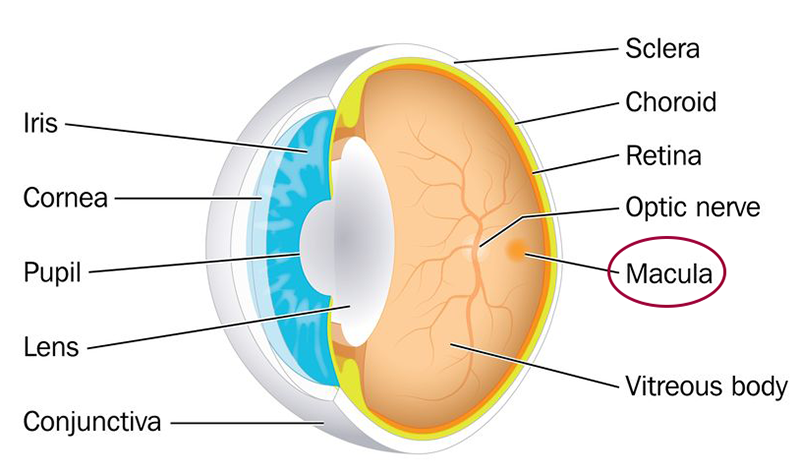Facts About AMD
AMD causes damage to the macula and can gradually destroy your central, sharp vision. AMD, or age related macular degeneration, is a common eye condition and a leading cause of vision loss among people age 55 and older. It is the most common cause of legal blindness in this age group. (Legal blindness means that a person can see 6/60 or less with glasses.) 
The macula is made up of millions of light-sensing cells. It is the most sensitive part of the retina and is smaller than the size of a pinhead. The macula allows us to make out sharp detail and lets us see objects that are straight ahead of us. For many, the loss of central vision due to macular degeneration can interfere with simple everyday activities, such as reading, writing, driving, recognising faces, watching television, cooking and fine work, even though colour vision and peripheral vision may remain clear.
What are the symptoms of AMD?
When the macula is damaged, the centre of your field of view may appear blurry, distorted, or dark. Over time, the blurred area may grow larger, or you may develop blank spots in your central vision. Objects can also appear to be less bright than they used to be. Straight lines can suddenly appear curved or wavy.
You should see our optometrists if:
- you have blurry vision when attempting to focus
- you have a loss in sharpness or saturation of colour
- more light is needed to see
- more time is needed to adjust to a sudden change in lighting conditions
- you have dark areas in your central vision
- you have difficulty recognizing people or objects
- objects or people appear to be different sizes when viewed from different eyes.
What causes macular degeneration?
What is macular degeneration? What causes it? Optometrist still don’t still know.
There are two forms of age-related macular degeneration: wet and dry. Dry AMD occurs when light-sensitive cells in the macula gradually break down. Seventy percent of AMD patients suffer from the dry form. Dry macular degeneration is diagnosed when yellowish spots known as drusen begin to accumulate in and around the macula. It is believed these spots are deposits or debris from deteriorating tissue.
In the wet form, tiny new blood vessels grow behind the retina which can cause bleeding, swelling and scarring. The wet form of the disease usually leads to more serious vision loss.
AMD advances slowly for some people; vision loss occurs over a long period. In others, the disease progresses more quickly and can lead to vision loss in one or both eyes or at different rates.
Is there a cure for AMD?
There’s no cure, but treatment for age-related macular degeneration may slow the disease or even improve vision.
Treatments for macular degeneration depend on the stage of the disease and whether it is the dry or wet form of the disease. Severe forms of dry macular degeneration can be operated upon, but treatments and success levels do vary. As with dry AMD, there is no proven cure for wet AMD, but certain treatments such photo-dynamic therapy and innovative new drugs, which inhibit the growth of blood vessels, have been of help for some sufferers. Nutritional intervention has also been helpful in slowing the progression of wet AMD.
Talk to our optometrists about the best way to manage your condition.
Who is at risk?
Age is a major risk factor for AMD. The disease is most likely to occur after age 60, but it can occur earlier. Other risk factors for AMD include:
- Race: AMD is most common among Caucasians
- Family history
- Disease and injury: diabetes, nutritional deficits, head injury, infection.
Can AMD be prevented?
You can reduce your chances of developing AMD by not smoking, wearing sunglasses, maintaining low blood pressure and cholesterol levels and eating a balanced diet with fruit, vegetables and fish or seeds high in omega 3 and 6.
How is AMD spotted?
The early and intermediate stages of AMD usually start without symptoms. Only a comprehensive dilated eye exam can detect AMD.
Our optometrist may also spot pigmentary changes under the retina. In addition to the pigmented cells in the iris (the coloured part of the eye), there are pigmented cells beneath the retina. As these cells break down and release their pigment, your eye care professional may see dark clumps of released pigment and later, areas that are less pigmented. These changes, however, will not affect your eye colour.
Because AMD has few symptoms in the early stages, it is important to have your eyes examined regularly. If you are at risk for AMD because of age, family history, lifestyle, or some combination of these factors, you should not wait to experience changes in vision before getting checked for AMD.
If you notice distortion or blurred vision, even if it doesn’t have much effect on your daily life, consult an eye care professional.
If you have experienced any of the above symptoms or are simply worried about your eyesight, contact John O’Connor Optometrists and come and see our eye specialists for an eye test.
What is macular degeneration? Still got questions? To get answers about everything eye related, call 09 522 1283 to speak to our Newmarket optometrists or 09 836 1731 to speak to an optometrist in Henderson.

